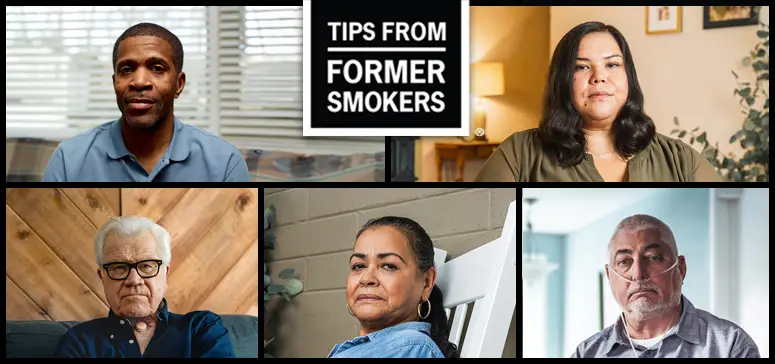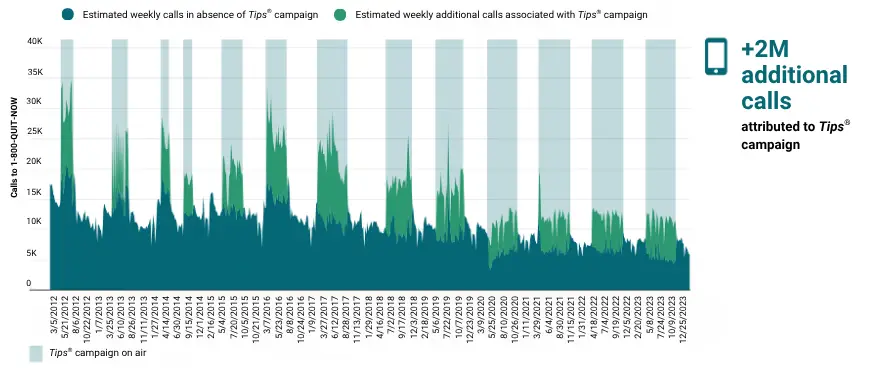Objective
The Centers for Disease Control and Prevention’s (CDC’s) Tips From Former Smokers® (Tips®) campaign is a federally funded media campaign to help adults quit smoking. It encourages people to try to quit, stay tobacco-free, and use support services. RTI International led a multiyear evaluation of Tips® to give CDC and the public strong, science-based evidence on the campaign’s effectiveness.
Approach
RTI leveraged different types of data and study methods to determine how the Tips® ads influenced quit attempts, successful quitting, and the use of resources like the 1-800-QUIT-NOW quitline. RTI also used these results to estimate how much the campaign improved health outcomes and reduced health care costs.
Impact
Since 2012, the campaign has reached more than 70% of U.S. adults who smoke. RTI’s evaluation data show that the campaign has helped more than 1 million people quit permanently and led to more than 2 million extra calls to 1-800-QUIT-NOW. These results are linked to more than 120,000 lives saved and more than $7 billion in health care savings.
What is the Tips From Former Smokers® Anti-Smoking Campaign?
The Tips® smoking cessation campaign started in 2012 and is the longest-running national campaign to help adults quit smoking. Ads have run on national television, streaming services, websites, digital platforms, radio, billboards, and more. The ads feature real people from different backgrounds telling their stories of how smoking-related illnesses affected them and their families. Each ad also shares free resources, including the 1-800-QUIT-NOW quitline, text programs, and websites.

Why Was the Tips® Tobacco Cessation Campaign Needed?
Although smoking rates have decreased since 2011, approximately 29 million Americans still smoked regularly in 2022. Smoking remains the leading cause of preventable death in the United States, killing more than 450,000 people each year. It also causes serious illness for 16 million people, and smoking-related health care costs exceed $225 billion every year.
Approach for Evaluating the Tips® Smoking Cessation Campaign
RTI used a wide range of data and methods to study the tobacco cessation campaign’s impact and show the campaign’s value to public health. The campaign is national and supported by public investment, so it was important that the results were scientifically sound and reflective of the whole country. RTI experts used two main sources of data:
- weekly call totals to 1-800-QUIT-NOW, broken down by area code; and
- a large national survey panel that followed people who smoke over time.
To determine the campaign’s effect on quitting smoking, we used a national survey panel that had more than 150,000 responses from people who smoke. Using these data, our experts examined how exposure to the ads affected behavior, like trying to quit. RTI also leveraged pre-post comparisons and experiments where different television markets received different levels of ad exposure. These results were used to estimate how many people quit smoking permanently, how many deaths were prevented, and how much money was saved in health care costs.
RTI experts also examined the campaign’s effectiveness in getting people to call 1-800-QUIT-NOW by comparing call volume data to the number of television ads that aired each week in 210 U.S. media markets. These data were used to build models that link ad volume to calls. We did a similar analysis on the impact of ad exposure on campaign website visits.
Tips® Campaign Impact on Smoking Cessation
Every year since 2012, more than 70% of people who smoke reported that they saw the Tips® ads on television or online. Survey data showed that, between 2012 and 2018, the campaign led to about 16 million quit attempts and 1 million people quitting for at least 1 year. More ad exposure was also linked to fewer people going back to smoking after quitting. Economic projections based on these results indicated that the campaign helped prevent 129,000 early deaths from 2012 to 2018, adding nearly 804,000 years of life. As a result of these health benefits, we estimated that the campaign saved $7.3 billion in smoking-related health care costs. These results showed that the Tips® smoking cessation campaign was effective in helping people quit, improving health, and reducing health care spending.

RTI’s evaluation also shows that the smoking cessation campaign led to sizable increases in the number of people looking for resources, including more calls to 1-800-QUIT-NOW and more visits to the campaign website. Between 2012 and 2023, the campaign was linked to almost 2.1 million extra quitline calls. Website visits also increased, showing strong and steady interest in quitting.

A Model of Excellence for Strong, Trustworthy Evaluation
Data show that the anti-smoking campaign was effective and has been a valuable investment. RTI’s long-term evaluation of the Tips® campaign is a strong example of how to measure the effectiveness of public health campaigns. Our research has led to more than 25 peer-reviewed studies documenting the campaign’s impact and examining topics such as how people respond to ads like those used by Tips® and what makes an ad effective. This work will continue to inform how large public health campaigns are evaluated in the future.
- Centers for Disease Control and Prevention (CDC)



